Pork loin and belly stuffed with pistachios, garlic and herbs.
-Full Post-

Lay the pork belly out skin side down. Cut the pork loin in half the long way, so you have two 8" pieces (in the photo I had some mismatched loin pieces, but I think you'll get the idea). Lay the loin along the long edge of the pork belly - the one you will be rolling - to be sure it fits neatly, end to end.
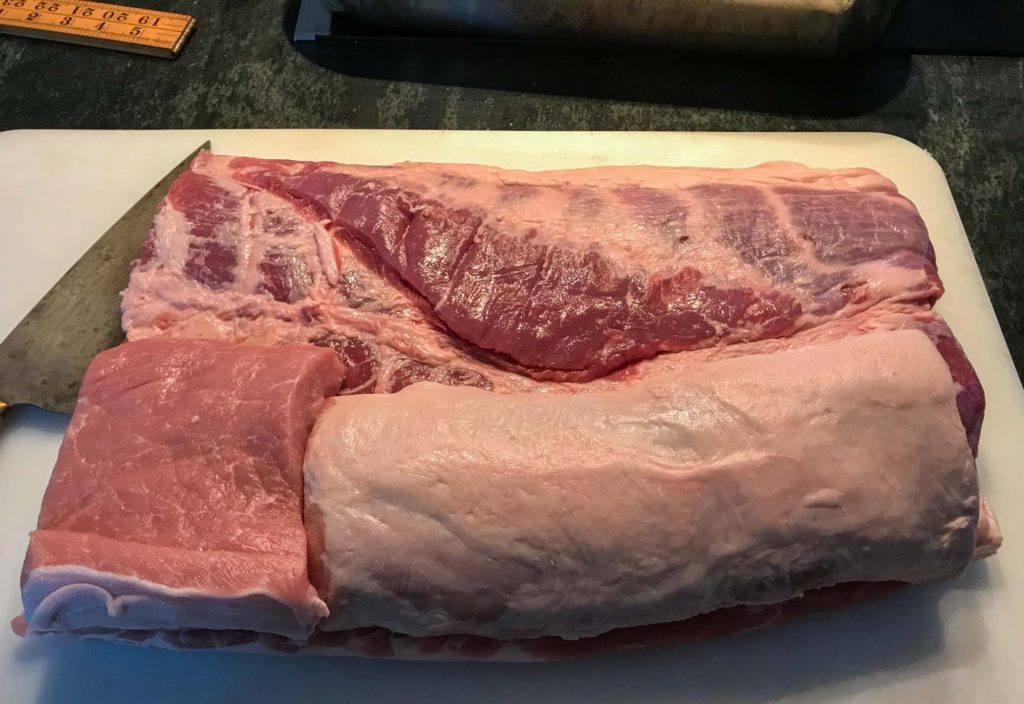
Lay the pork belly skin side up and score the skin in a diamond pattern on the bias at about one inch intervals, about a quarter inch deep. Cut only through the skin, not the flesh. A box cutter with a fresh blade works better at this than almost any kitchen knife. Flip the belly again and try a practice roll with the loin in place. You should be able to tuck up the pork so that the ends of the belly meet.
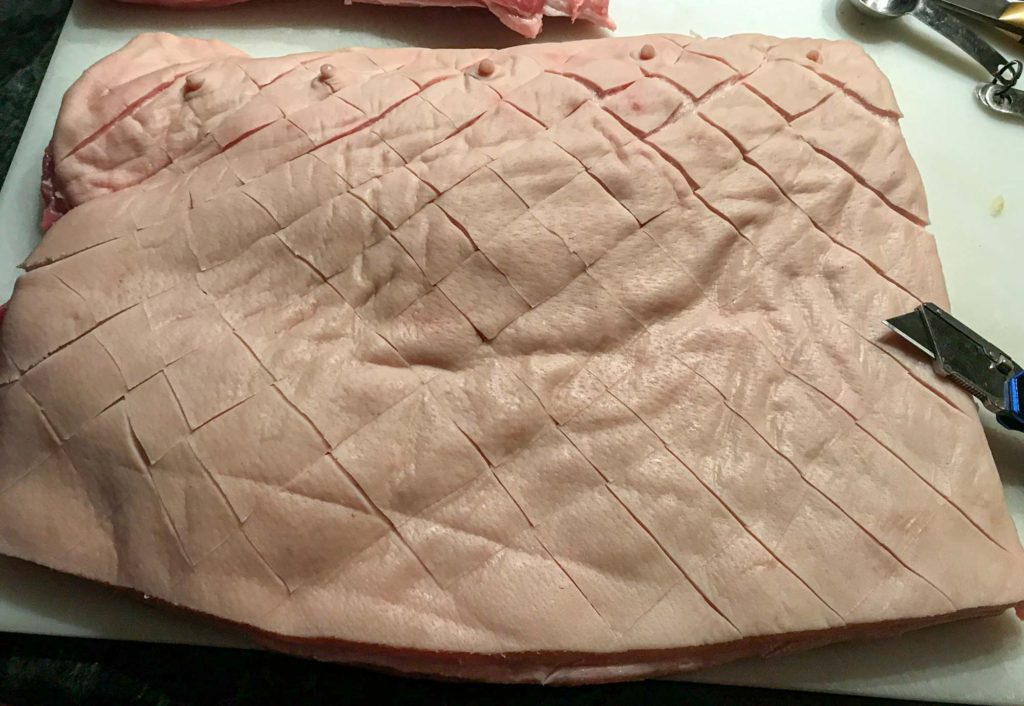
Process the garlic cloves in the food processor. Add the nuts and the salt and process further, pulsing now and then, until you have a rough sand texture. Add the sage, parsley and rosemary. With the processor running (you're basically making a thick pesto), drizzle in the olive oil. Don't let it get too smooth. Stir down as needed with a rubber spatula. Toast the fennel seed, peppercorns and allspice berries in a dry, medium hot pan until fragrant. Blend with the juniper berries, if using, in a spice grinder or mortar and pestle, until powdered. Grate the orange or lemon peel. Add the spices and grated peel to the food processor and pulse once or twice more, just to blend.
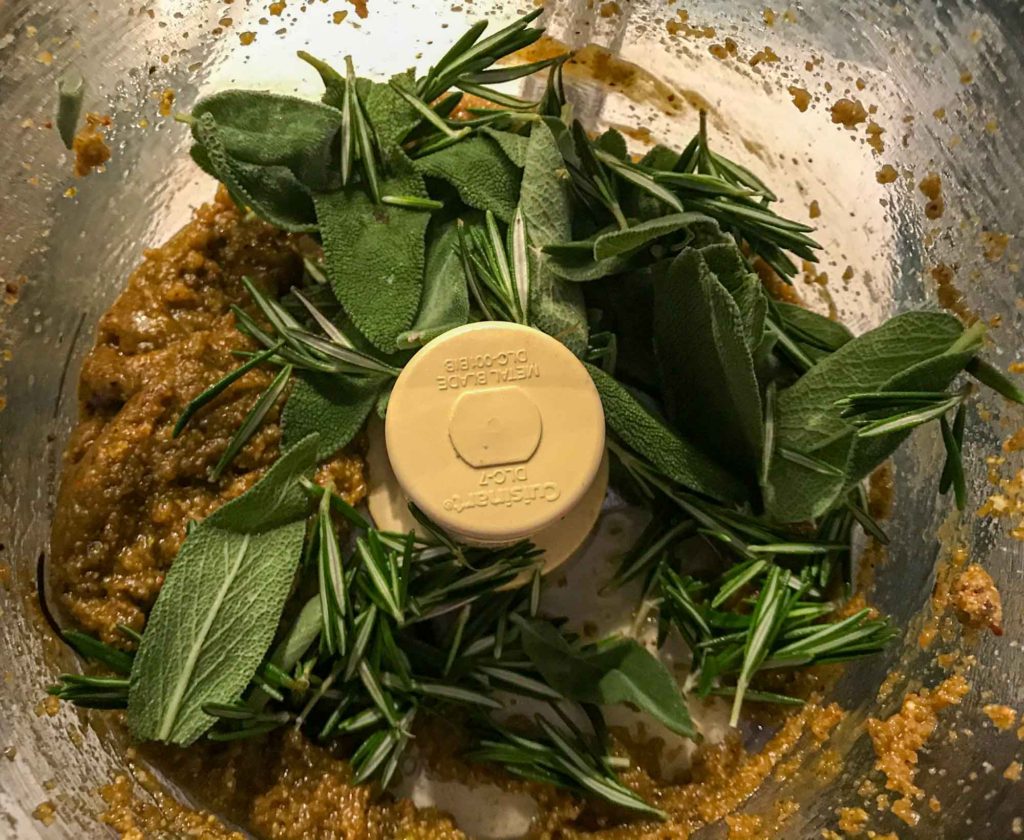
Liberally salt and pepper the inside of the pork belly as well as the loin! Don't omit this step; the paste itself is salty, but not enough to season all that meat from the inside. Spread the herb mixture evenly over the meat, including the area covered by the loin. Roll up tightly from the loin end.
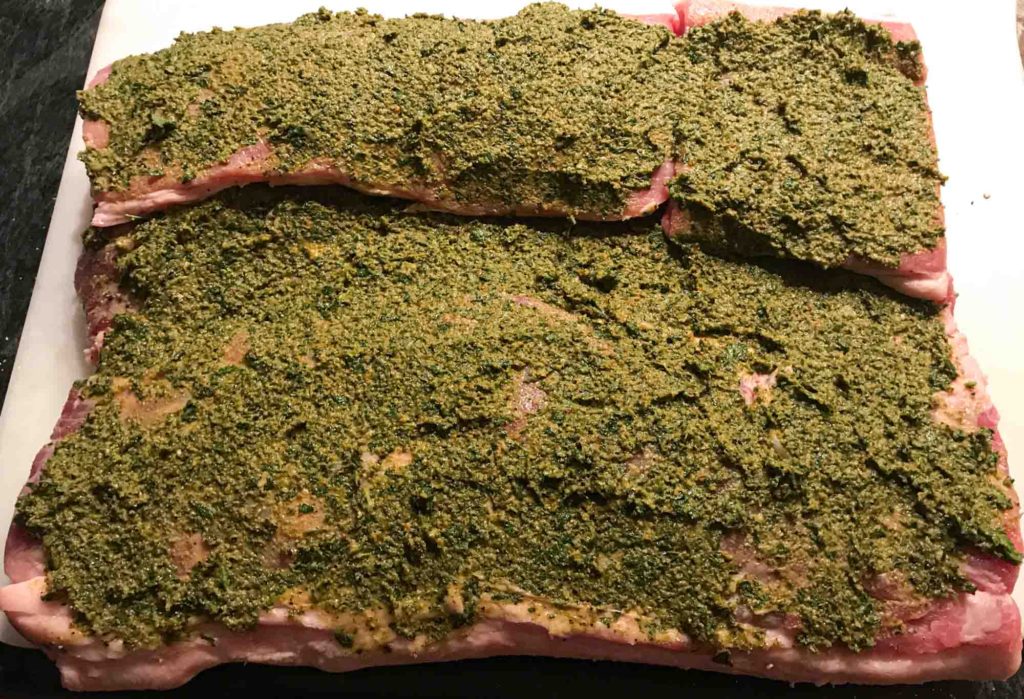
Have some precut pieces of butcher's twine or other clean string in place on the countertop at roughly one inch intervals, and place the roll over the string. Tie up the roll, ends first, as pictured at the top of this recipe. It's ideal at this point to let the pork rest in the fridge, covered in plastic wrap, at least overnight to let the seasonings penetrate the meat. When you're ready to roast, place on a baking rack and put the pan in a preheated oven at 450 degrees F for 30 minutes. Reduce the heat to 300 degrees and pour about a cup and a half of the liquid of your choice (water, white wine, dark beer, black coffee or a mix) on the bottom of the pan to prevent the drippings from burning. Continue roasting for about another 2 hours, checking every half hour so, or until the internal temperature hits 160. Let rest, uncovered or very loosely tented, for at least 20 minutes before serving. Cut about half inch slices onto a platter and serve with pan juices.
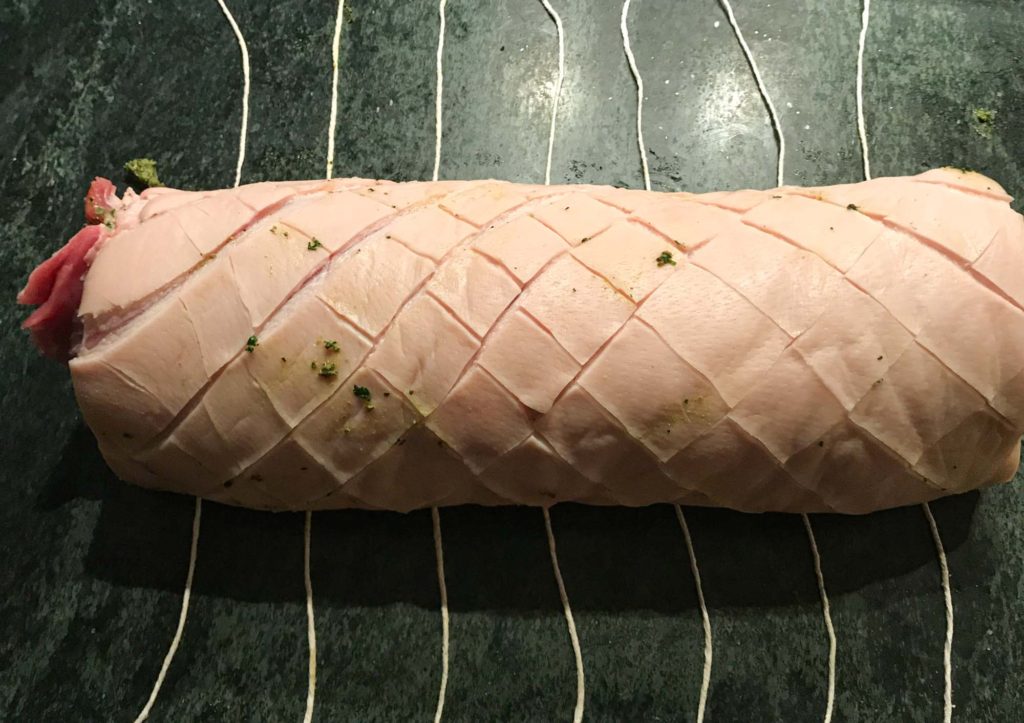
It's fine to buy a lot of cheap meat and freeze what you can't use. You can also just double the filling recipe and make one enormous roll - a full pork belly is around 24" - and freeze the whole thing, stuffing and all, for a month or two. In any case, a chunk of frozen pork belly is one of the nicest things to have around the house.
Don't want to do the nuts? Substitute breadcrumbs or omit entirely.
The reason you tie both ends first is because . . . if you start out at just one end you will squish a lot of filling out the other. Maybe. Anyway, that's what I do.
To cook the porchetta in the picture below, I used my outdoor, wood-fired oven. This is huge fun but less of an advantage than you might think, unless (!) your real goal is to hang around outside and drink beer while pretending to check on things. It's still just basically an oven that starts out at around 450 and then drops 25 degrees every half hour or so. You could also cook this very low and slow, either starting at 300 for a few hours or even overnight at around 225, then raising the temp to 500 to crisp the skin - if you do that, watch it carefully. Also - covering the roast too closely as you let it rest before serving will remove some of that luscious crispness.
I'm a fan of adding dark beer and water, or light beer and black coffee, to the bottom of the pan. I don't find that it softens the skin, and you get great pan juices.
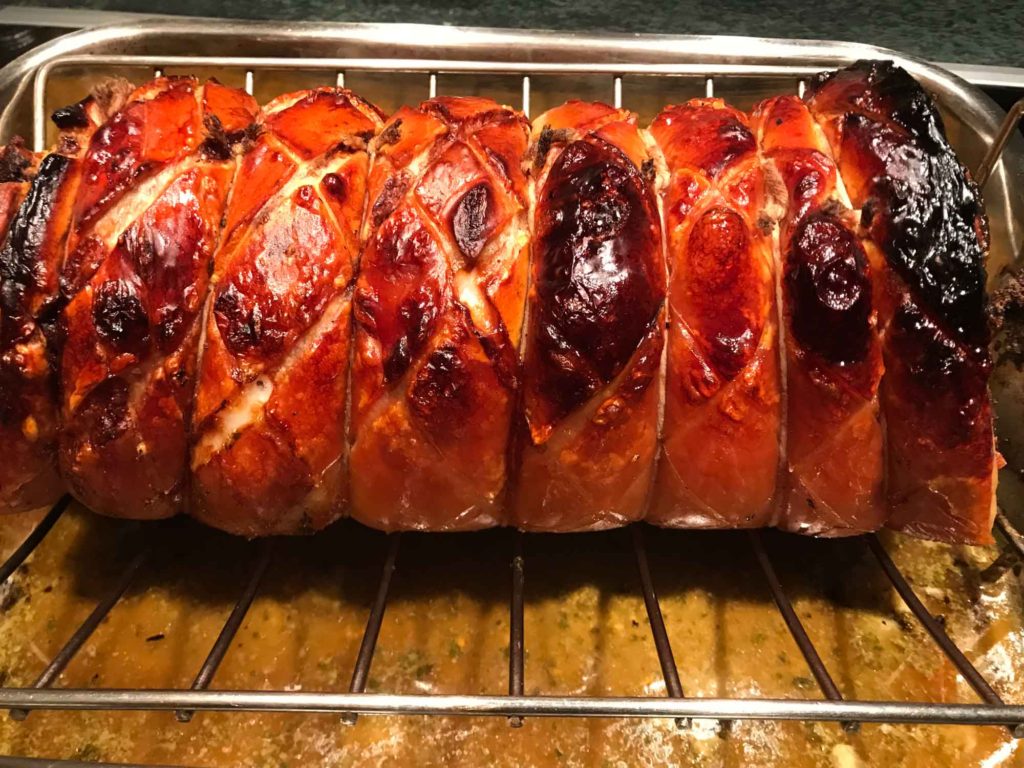
Ingredients
Directions
Lay the pork belly out skin side down. Cut the pork loin in half the long way, so you have two 8" pieces (in the photo I had some mismatched loin pieces, but I think you'll get the idea). Lay the loin along the long edge of the pork belly - the one you will be rolling - to be sure it fits neatly, end to end.

Lay the pork belly skin side up and score the skin in a diamond pattern on the bias at about one inch intervals, about a quarter inch deep. Cut only through the skin, not the flesh. A box cutter with a fresh blade works better at this than almost any kitchen knife. Flip the belly again and try a practice roll with the loin in place. You should be able to tuck up the pork so that the ends of the belly meet.

Process the garlic cloves in the food processor. Add the nuts and the salt and process further, pulsing now and then, until you have a rough sand texture. Add the sage, parsley and rosemary. With the processor running (you're basically making a thick pesto), drizzle in the olive oil. Don't let it get too smooth. Stir down as needed with a rubber spatula. Toast the fennel seed, peppercorns and allspice berries in a dry, medium hot pan until fragrant. Blend with the juniper berries, if using, in a spice grinder or mortar and pestle, until powdered. Grate the orange or lemon peel. Add the spices and grated peel to the food processor and pulse once or twice more, just to blend.

Liberally salt and pepper the inside of the pork belly as well as the loin! Don't omit this step; the paste itself is salty, but not enough to season all that meat from the inside. Spread the herb mixture evenly over the meat, including the area covered by the loin. Roll up tightly from the loin end.

Have some precut pieces of butcher's twine or other clean string in place on the countertop at roughly one inch intervals, and place the roll over the string. Tie up the roll, ends first, as pictured at the top of this recipe. It's ideal at this point to let the pork rest in the fridge, covered in plastic wrap, at least overnight to let the seasonings penetrate the meat. When you're ready to roast, place on a baking rack and put the pan in a preheated oven at 450 degrees F for 30 minutes. Reduce the heat to 300 degrees and pour about a cup and a half of the liquid of your choice (water, white wine, dark beer, black coffee or a mix) on the bottom of the pan to prevent the drippings from burning. Continue roasting for about another 2 hours, checking every half hour so, or until the internal temperature hits 160. Let rest, uncovered or very loosely tented, for at least 20 minutes before serving. Cut about half inch slices onto a platter and serve with pan juices.

It's fine to buy a lot of cheap meat and freeze what you can't use. You can also just double the filling recipe and make one enormous roll - a full pork belly is around 24" - and freeze the whole thing, stuffing and all, for a month or two. In any case, a chunk of frozen pork belly is one of the nicest things to have around the house.
Don't want to do the nuts? Substitute breadcrumbs or omit entirely.
The reason you tie both ends first is because . . . if you start out at just one end you will squish a lot of filling out the other. Maybe. Anyway, that's what I do.
To cook the porchetta in the picture below, I used my outdoor, wood-fired oven. This is huge fun but less of an advantage than you might think, unless (!) your real goal is to hang around outside and drink beer while pretending to check on things. It's still just basically an oven that starts out at around 450 and then drops 25 degrees every half hour or so. You could also cook this very low and slow, either starting at 300 for a few hours or even overnight at around 225, then raising the temp to 500 to crisp the skin - if you do that, watch it carefully. Also - covering the roast too closely as you let it rest before serving will remove some of that luscious crispness.
I'm a fan of adding dark beer and water, or light beer and black coffee, to the bottom of the pan. I don't find that it softens the skin, and you get great pan juices.


Leave a Reply